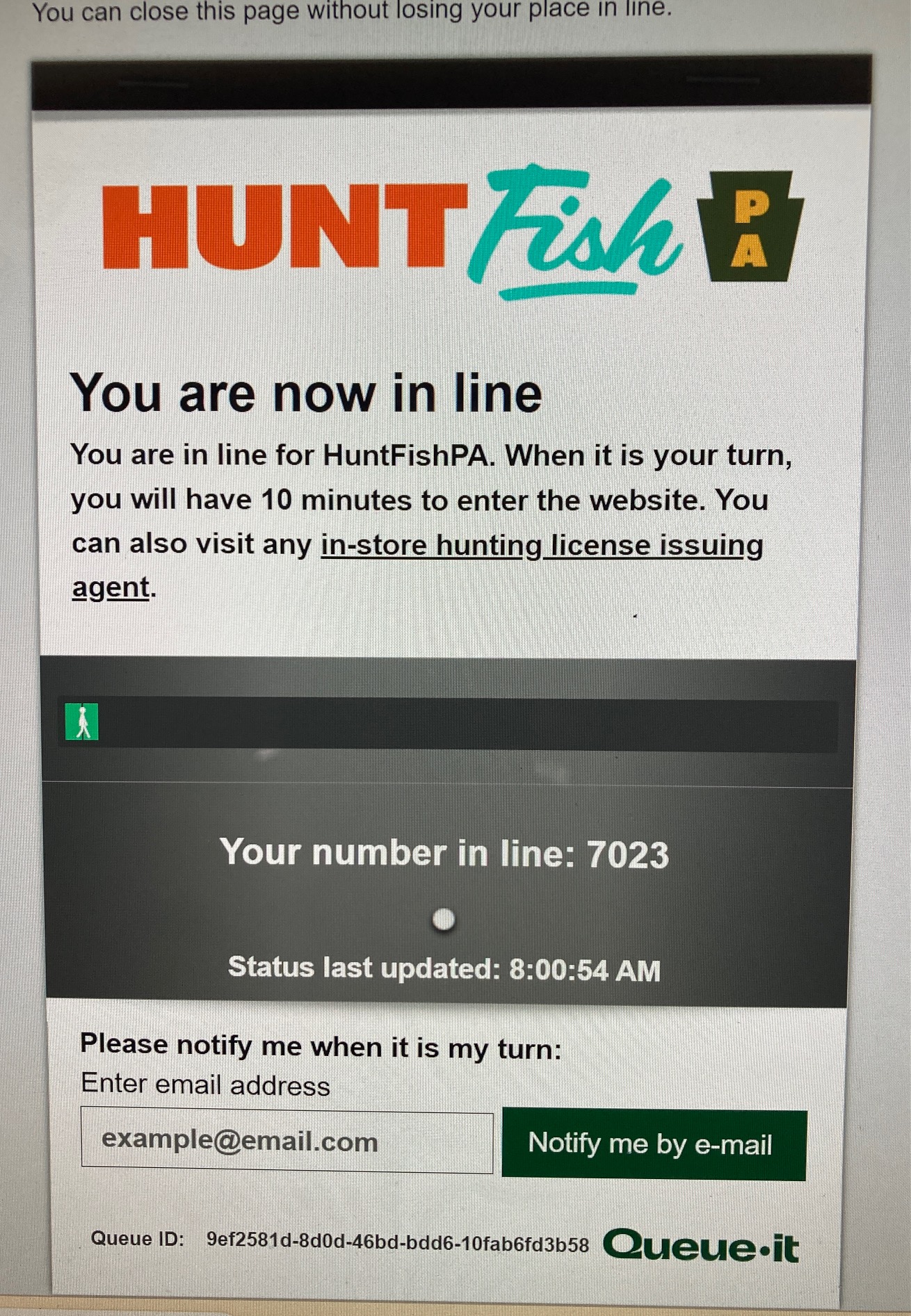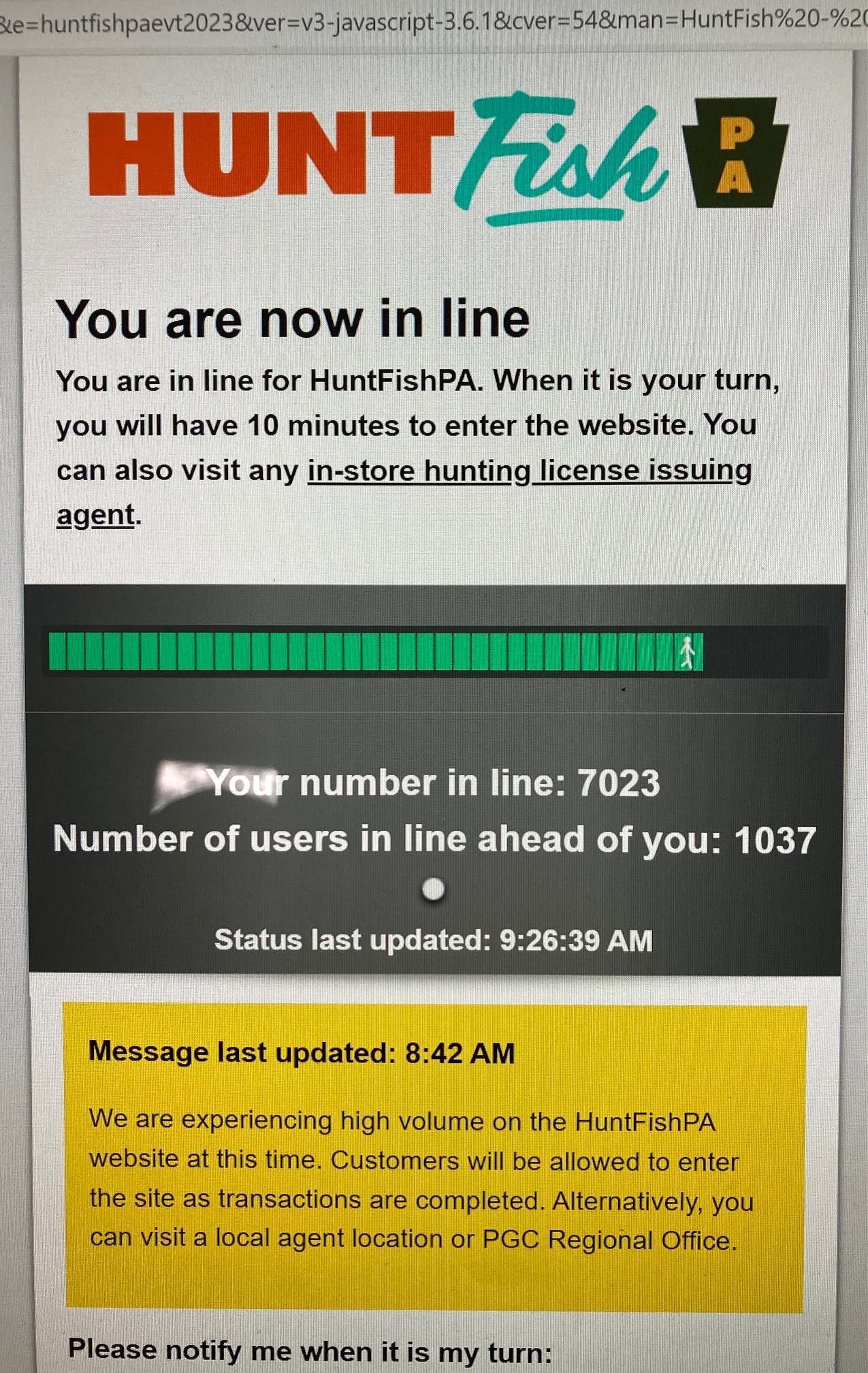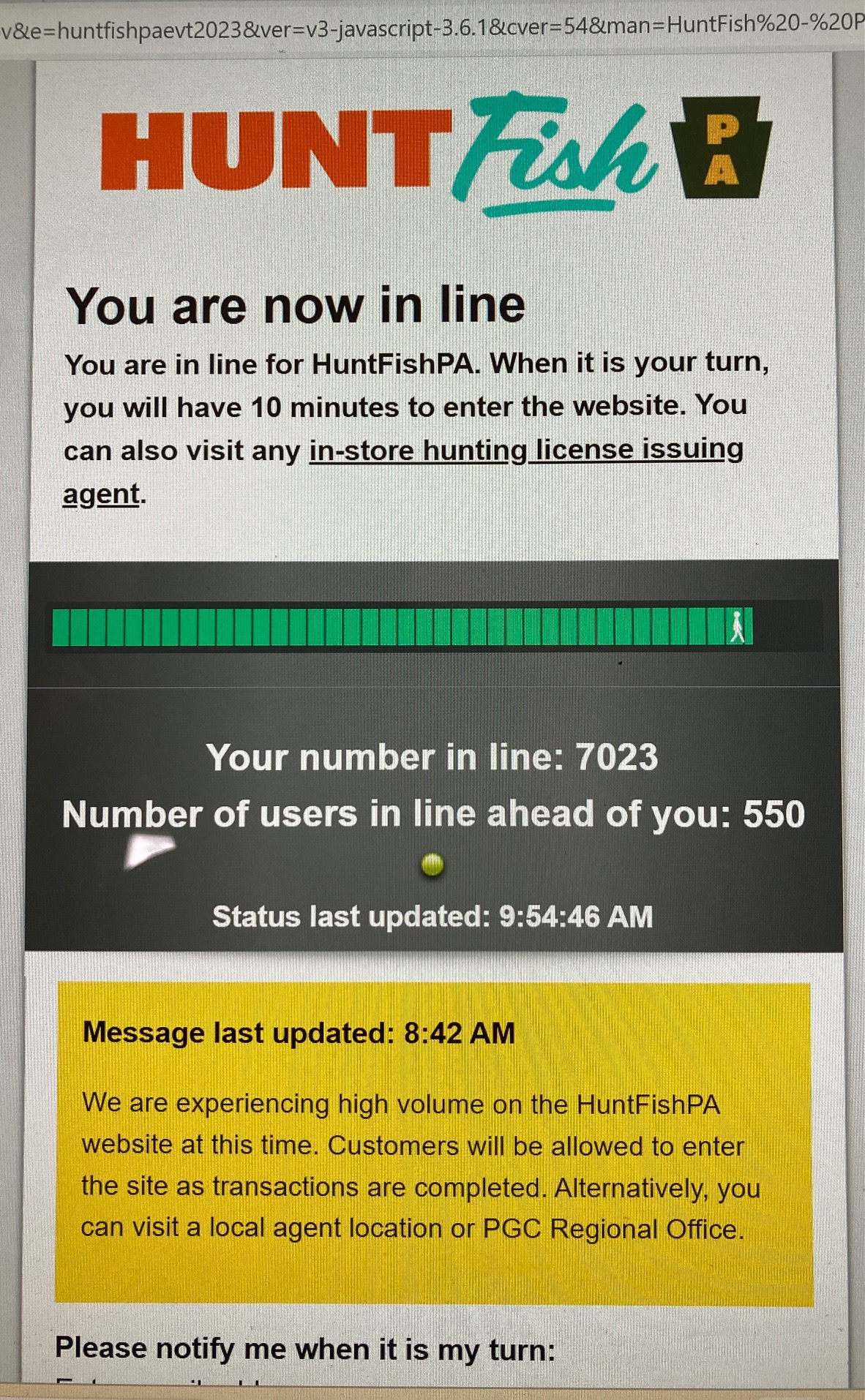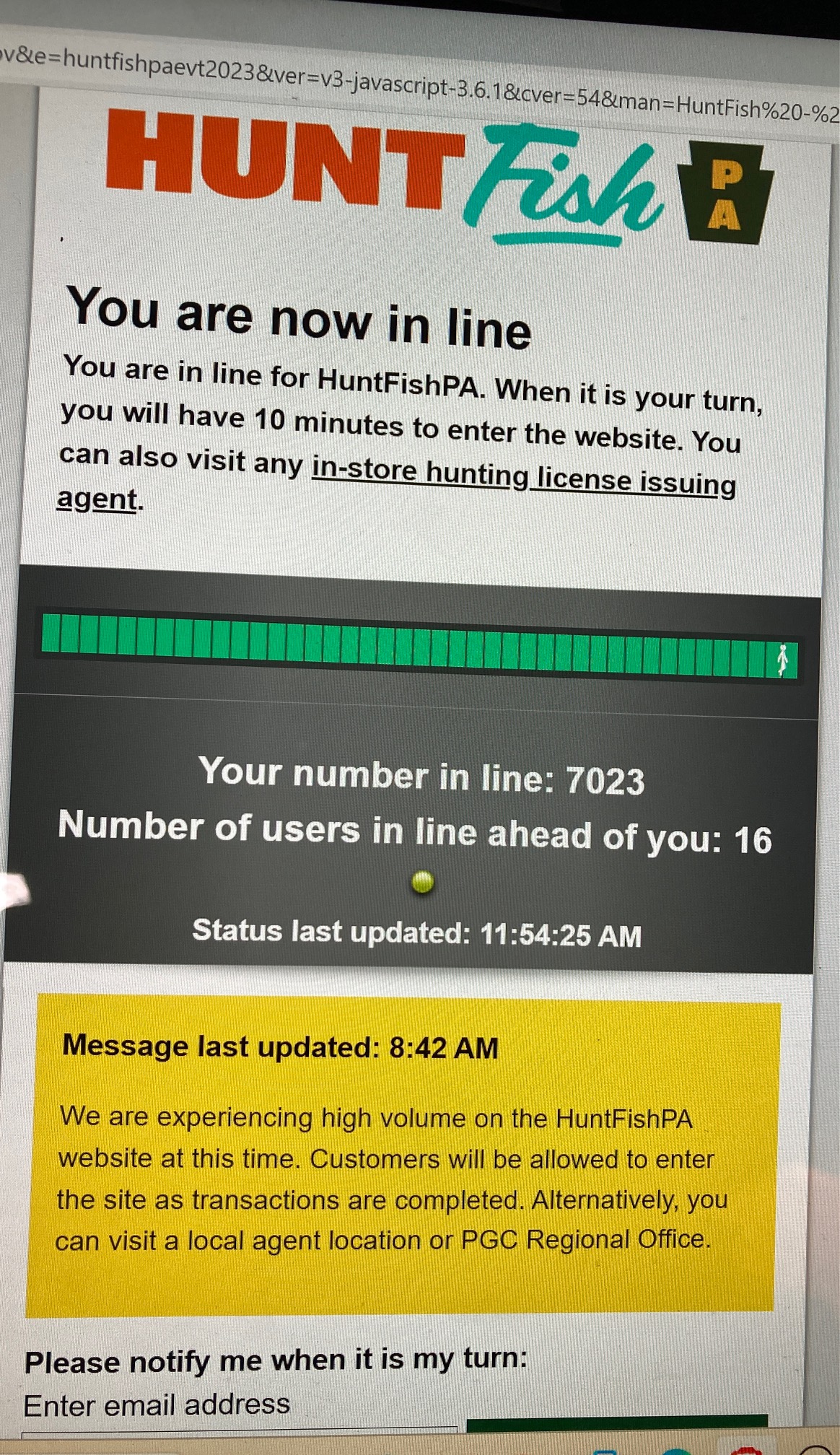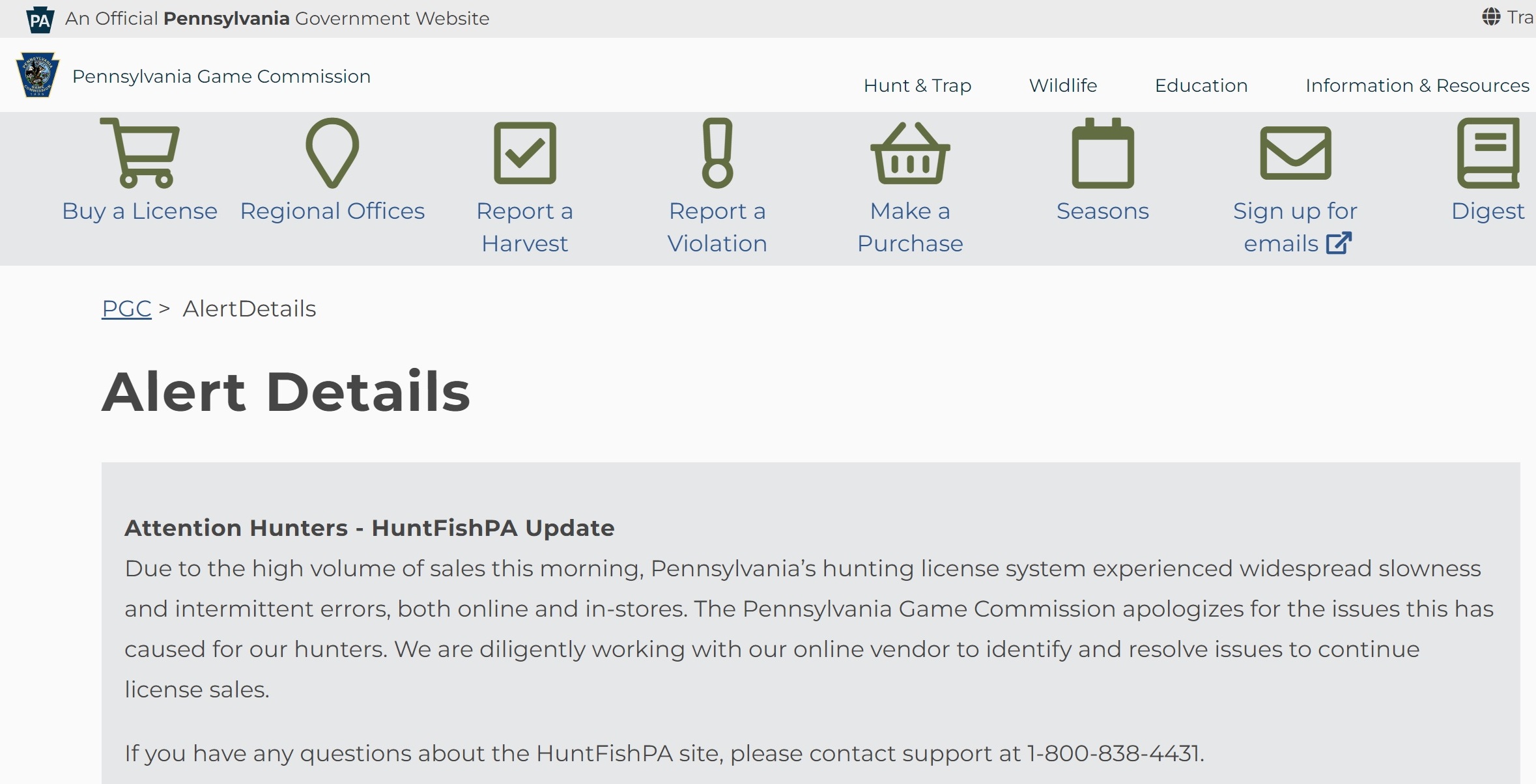Posts Tagged → wmu
How’d that go? PA begins online hunting license & tag sales
Today at 8:00 AM marked the first day of the Pennsylvania Game Commission’s true entry into the modern world of home computers and the Internet. This probably sounds like an unnecessarily harsh or even a commonly outlandish criticism of the venerable PGC, but it is a technological fact that today marks the very first step by the 1895-founded-and-minded wildlife agency into directly integrating with its customer base.
And it has not gone well, although it could have gone a lot worse. Monday end-of-business hours analysis shows the PGC website processing about 7,090 license purchases per hour. That is about 118 per minute, which is a lot faster than the roughly 1,900 licenses per hour purchased in the early time frame I operated in. Given all of the little moving parts involved, especially that carefully measured doe tag purchase, I guess I can see why this is taking longer than the two to three minutes total that each person expected to spend on it. It still frustrated me and others who are not at war with PGC.
The process has been marred by exceptionally long waits, both in-person at brick and mortar retailers and online, with lots of “system crashes” and people standing in line for hours, spawning humorous memes like the old and now former pink doe tag envelope saying “Miss Me Yet?” I like the meme of the skeleton passed out over the desktop computer “Waiting for my 21st century Internet purchase from the PA Game Commission.”
The truth is that this day had to come, sooner or later. The old double-stamped pink envelope US Mail process was increasingly marred by the US Postal Service’s incredibly ever worse performance, to the point where people were photographing piles of time-sensitive pink envelopes sitting in heaps in some post office rooms, waiting for who knows what or who knows who. No one likes to be treated differently than everyone else, and the pink envelope lottery was an idea from 1945 that worked when postal employees did their jobs. These days, the Postal Service is notoriously unreliable. We can’t have a doe tag distribution process that relies on unreliable people and institutions. Even when the applying hunter does everything correctly, his or her pink doe tag envelope might take a wrong turn at Albuquerque and arrive days or weeks after the last doe tag was distributed. Which greatly impacts the hunter’s plans and prospects for that upcoming hunting season.
My own experience today had me first sleeping fitfully all night like it was hunting season, and finally dragging myself out of bed and hunkering down by the laptop well before the 8:00 AM beginning of the online purchase process at www.huntfishpa.gov. Almost like opening day of deer season and sitting down at an ambush site. Except this process revealed itself as having actually started well before the appointed 8:00 AM hour, as I was number 7,023 in line when I signed into my PGC huntfishpa account. With barely any coffee in my veins to buffer this unhappy revelation, an ice cold shock ran through me as I realized I was both early and yet already very late to the process. Thousands of hunters were ahead of me in an online process that was unknown, untested, and sure to have its ups and downs and delays.
The big ticket item for most of us early applicants is getting the doe tag of our first choice Wildlife Management Unit. It is why we stayed in the game til the very end. And the numbers tell the tale: My own first choice, WMU 2G, sold 17,000 doe tags by 5:00 PM today, about twice as many doe tags as any other WMU. There is a strong fear in a lot of guys that if you don’t get in line early either online or at a store, you won’t get your coveted doe tag in your primary hunt region. Fact is, with the ever popular northern “Big Woods” WMU 2G, that fear is well founded. There are many more hunters wanting WMU 2G doe tags than there are WMU 2G doe tags to hand out. The early bird gets this worm, every year.
[UPDATE: At 9:42PM I looked at the doe tag numbers and 23,502 WMU 2G doe tags out of the 35,000 total allocation for that WMU have been sold so far. A sale rate far beyond any other WMU. This means that 2G will be sold out by Tuesday early morning hours. The hunter demand for Big Woods 2G tags has always been high, we knew it, and now we get to see how that demand plays out when the hunters themselves are put in direct control of their tag orders]
Four hours and ten minutes later, having obsessively hovered over my laptop screen the entire time while emailing and bitchfest-texting with friends in both better and worse positions than I, I finally had ordered my general hunting license plus all of the additional license and permits I get, like furtaker (trapping), the annual elk application (I will take anything ya got anywhere ya got it), muzzleloader, archery, spear, atl-atl, sling, blowgun, black bear, fisher, bobcat, armadillo, hog, dog, rat, bat, and zinjanthropus tags. And yes, I got my WMU 2G doe tag, which enables me to hunt the way I enjoy most – solo pack and rifle and maybe an overnight and campfire somewhere way off the beaten path and far from roads and people, and the promise of a long and heavy pack-out of boned-out meat with a single doe’s ear and a completed tag attached. This kind of hunt is the most rewarding among big game hunters everywhere. Guys sitting in warmed box blinds overlooking fields and ravines have no idea.
So yeah, I waited and waited to ensure I got that 2G doe tag. A lot of my Big Woods hunting depends on it.
Anyone old enough to pick up on the Bugs Bunny theme above will understand where I am coming from; it was a loooong and kind of zany morning. In this day and age of Amazon and eBay and Gunbroker one-stop-shop badda bing badda bang badda boom go online and it’s yours two minutes later, Pennsylvania’s entry into the online hunting license world was practically Stone Age. New York has about as many hunters as Pennsylvania, and I have never encountered anything like this when I order my hunting license and tags from NY. It is usually immediate. Even Kentucky’s online hunting license and elk tag application process is faster than ours was today.
I am not picking on Kentucky….but come on, we all know it, Kentucky is not known for being especially technologically advanced. And yet….!
On the one hand, we must must give PGC credit for taking the long step out of 1895 and into the computer and internet age. This step the agency took this morning was one small step for PGC and one giant leap for hunterkind, or maybe the reverse, or whatever….. something like this. It is a big deal and I send you guys three cheers. Three grouchy cheers. Let’s not do this again, OK?
Yes, today’s license purchase has been marred by delays that seem unacceptable, but we all know that the PGC’s public employees have way too much pride to let this situation continue. It is a fact that a lot of employees and contractors will be working all night on this new system, and that by the time 8:00 AM breaks tomorrow, a lot of the glitches and delays we experienced today will be a bad memory for some, and a non-experience for a million others.
PA’s must-do 21st century deer management policy
When Gern texted me on November 12th “planning to plant the entire farm with grass next Fall… 100% hay… can’t afford to feed wildlife. Going broke trying to make money,” I knew that my best deer management efforts had finally failed over the past 13 years.
Every year I work hard to make sure our deer season is as productive as possible. Because our tenant farmer pays us a per-acre rent every year, which covers the real estate taxes and some building maintenance, and for 13 years he has grown soybeans, corn and hay in various rotations across the many fields we have. Our arrangement has generally worked out well both ways, but that text message ended my sense of satisfaction.
While I do wear dirty bib overalls when I run the sawmill and also when I try to impress people who don’t know me, Gern is the actual farmer who tills (broad sense), fertilizes, plants, and harvests a very large farm property in Dauphin County, some of which I own and all of which I manage. Our property is one of many that comprise about 30,000 acres of farm land that Gern and his family cultivate in Central Pennsylvania. To say that his family works hard is the understatement of all understatements. Gern embodies AMERICA! in flesh and spirit, and to see him so utterly beaten down by mere deer is heartbreaking.
Over the years I knew that both overabundant deer and bears were taking a significant toll on our grain crops (Gern’s primary source of family income), and so I worked hard to recruit the kinds of good hunters who would help us annually whittle down the herds, so that the pressure was taken off of our crops. About five years ago I proudly photographed one of our late-summer soybean fields, at about four super healthy feet high, indicating a minimal amount of deer damage. When I passed the soybean field pictures around to other farmers and land managers, nothing but high praise returned. And so I patted myself on the back for our successful deer management, and congratulated our guest hunters, who were killing about 25-35 deer a year on our property. Our hunters were filling an impressive 50% to 65% of the roughly 54 DMAP deer management tags we hand out every year, as well as some of their buck tags and WMU 4C tags.
But, change is life’s biggest constant, and while I rested on my hunting laurels, deer hunting changed under my feet. The past few years have seen a lot of change in the hunting world. First and biggest change is that hunters in Pennsylvania and other states are aging out en masse, with fewer replacements following them. This means that a lot less pressure is being brought to bear on the deer herd. Which means a lot more deer are everywhere, which is not difficult to see if you drive anywhere in Pennsylvania in a vehicle. There are literally tons of dead deer along the side of every road and highway, everywhere in Pennsylvania. We should be measuring this at tons-of-deer-per-mile, not just the number of dead deer and damaged vehicles. Frankly this overabundant deer herd situation is out of control not just for the farmers who feed Americans, but for the people who want to safely drive their vehicles to the grocery store. Hunters are sorely needed to get this dangerous situation under control, and yet Pennsylvania’s deer management policies favor overabundant deer herds to keep older hunters less crabby.
So, because I am about to break out the spotlights and AK47 to finally manage our farm deer the way they need to be managed (and yes, PA farmers are allowed to wholesale slaughter deer in the crops) (and yes, I feel the same way about our favorite forested places in the Northern Tier), here below is the kind of deer management/ hunting policy Pennsylvania needs via the PGC, if we are going to get the out-of-control deer herd genie back into its bottle and stop hemorrhaging farmland on the altar of too many deer:
- Archery season is too long. At seven weeks long, the current archery season lets a lot of head-hunters stink up the woods, cull the very best trophy bucks, and pressure the deer enough to make them extra skittish and nocturnal before rifle season begins. Even though rifle season is our greatest deer management tool. The same can be said of bear season, which is the week before rifle season. So shorten archery season and lengthen rifle season, or make the opening week of deer season concurrent with bear season, like New York does.
- Rifle season must be longer, and why not a longer flintlock season, too? Is there something “extra special” about deer come the middle of January, that they are prematurely off limits to hunting? Most bucks begin to drop their antlers in early February. Have three weeks of rifle season and then five weeks of flintlock season until January 30th, every year. Or consider flintlock hunting year ’round, or a spring doe season in May.
- More doe tags are needed. There are too few doe tags to begin with, and most doe tags sell out and are never used. This is especially true in WMUs 5C and 5D, where despite enormous tag allocations, tags quickly become unavailable. That is because individual hunters can presently buy unlimited numbers of doe tags, for some reason having to do with the way deer were managed in the 1980s…c’mon, PGC, limit of two or three doe tags for each hunter in these high-density WMUs, and at least two doe tags in Big Woods WMUs like 2G and 4C.
- Despite good advancements in reducing the regulatory burden on deer hunters this past season, there are still too many rules and restrictions. For example, why can’t our muzzleloading guns have two barrels? Pedersoli makes the Kodiak, a fearsome double percussion rifle that would be just the ticket for reducing deer herds in high deer density WMUs where the PGC says they want more deer harvests. But presently it is not legal. Another example is the ridiculous interruptions in small game seasons as they overlap with bear and deer seasons. This bizarre on-again-off-again discontinuity of NOT hunting rabbits while others ARE hunting deer is an unnecessary holdover from the long-gone, rough-n-ready bad old poaching days of Pennsylvania wildlife management. PA is one of the very few states, if the only one at all, with these staggered small game and big game seasons. Bottom line is hunting is supposed to be fun, and burdening hunters with all kinds of minutiae is not only not fun, it is unnecessary. Other states with far more liberal political cultures have far fewer regulations than Pennsylvania, so come on PA, give fun a try.
- Artificial deer feeding with corn, alfalfa, oats etc on private land during all deer and bear seasons must end. Not only does this “I’m saving the poor starving deer” nonsense lead to spreading deadly diseases like CWD, it artificially draws deer onto sanctuary properties and away from nearby hunters. Or it is baiting, plain and simple. Feeding causes overabundant deer to avoid being hunted during hunting season, but then quickly spread out on the landscape where they eat everything out of house and home when hunting season ends. This year up north (Lycoming and Clinton counties) is a prime example. We had no acorns to speak of this Fall, and whatever fell was quickly eaten up by early November. As the weeks rolled on through hunting season, the deer began leaving their regular haunts and unnaturally herding up where artificial feed was being doled out. This removed them from being hunted, and creates a wildlife feeding arms race, where those who don’t feed wildlife run the risk of seeing none at all. So either completely outlaw artificial feeding or let everyone do it, including hunters, so they can compete with the non-hunters. And yes, people who buck hunt only, and who do not shoot does, and who put out corn and alfalfa etc. for deer during hunting season, are not really hunters. They are purposefully meddling in the hunts of other people by trying to keep them from shooting “my deer.”
- PGC must better communicate to its constituency that too many deer result in unproductive farms that then become housing developments. Because the landowner and farmer must make some money from the land, if farm land can’t grow corn, it will end up growing houses, which no real hunter wants. So real hunters want fewer deer, at numbers the land and farms can sustain.
My comments to the PA Game Commission
The Pennsylvania Game Commission board of commissioners will be meeting this weekend, to set next season’s dates and bag limits. Like many other people, I submitted comments by email last week. From past experiences with this, I know that the commissioners read comments and requests from the public. Some of my comments, and those of my son, have received direct feedback from various members of the board.
A key to getting the commissioners to read and truly consider your comments is to submit them with plenty of time for the recipients to read them. If you submit comments a day or two before the meeting, it’s a very low likelihood of anyone having time to read them. Also, try to keep comments short, to the point, and sweet. Comments with prolonged bitching, whining, and playing biologist when you have no training or education or even a novice’s interest in wildlife biology, are all ways to ensure that your audience at best glances at your comments.
“Dear Commissioners,
Hunting should be fun, and therefore our small game seasons should run unbroken from their Fall opening to their February close. Whatever long gone reason for the on again-off again pattern of small game seasons, Pennsylvania must create opportunities for everyone. No biological reason exists for hiccup-style seasons. Few if any other states have this odd pattern. Let’s just let our hunters have fun and hunt.
In that vein, please consider allowing bodygrip traps on running pole sets in our most rural WMUs. The idea that a loose domestic dog is going to get caught in a trap in the middle of a state forest wilderness is preposterous. Same is true on private land. Same goes for allowing snares. We need all the tools we can get to manage coyotes. With now three years of crazy freeze-thaw-rain winter weather cycles, it’s impossible to rely on footholds. Cable restraints should be allowed throughout the whole season, and snares should be allowed on private land and or on public land in the Big Woods WMUs.
Finally, please put one of our Sundays on the day after the Saturday bear rifle opener, and another Sunday on the day after the Saturday deer rifle opener. This will create the most energy and excitement for our hunters. Even better, make bear and deer rifle concurrent!
Thank you for considering my thoughts,
–Josh”
